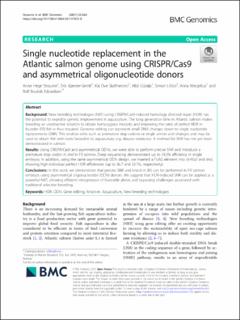| dc.contributor.author | Straume, Anne Hege | |
| dc.contributor.author | Kjærner-Semb, Erik Nordtorp | |
| dc.contributor.author | Skaftnesmo, Kai Ove | |
| dc.contributor.author | Guralp, Hilal | |
| dc.contributor.author | Lillico, Simon | |
| dc.contributor.author | Wargelius, Anna | |
| dc.contributor.author | Edvardsen, Rolf Brudvik | |
| dc.date.accessioned | 2022-03-02T11:41:19Z | |
| dc.date.available | 2022-03-02T11:41:19Z | |
| dc.date.created | 2022-02-10T14:14:57Z | |
| dc.date.issued | 2021 | |
| dc.identifier.citation | BMC Genomics. 2021, 22 . | en_US |
| dc.identifier.issn | 1471-2164 | |
| dc.identifier.uri | https://hdl.handle.net/11250/2982435 | |
| dc.description.abstract | New breeding technologies (NBT) using CRISPR/Cas9-induced homology directed repair (HDR) has the potential to expedite genetic improvement in aquaculture. The long generation time in Atlantic salmon makes breeding an unattractive solution to obtain homozygous mutants and improving the rates of perfect HDR in founder (F0) fish is thus required. Genome editing can represent small DNA changes down to single nucleotide replacements (SNR). This enables edits such as premature stop codons or single amino acid changes and may be used to obtain fish with traits favorable to aquaculture, e.g. disease resistance. A method for SNR has not yet been demonstrated in salmon. | en_US |
| dc.language.iso | eng | en_US |
| dc.title | Single nucleotide replacement in the Atlantic salmon genome using CRISPR/Cas9 and asymmetrical oligonucleotide donors | en_US |
| dc.type | Peer reviewed | en_US |
| dc.type | Journal article | en_US |
| dc.description.version | publishedVersion | en_US |
| dc.source.pagenumber | 8 | en_US |
| dc.source.volume | 22 | en_US |
| dc.source.journal | BMC Genomics | en_US |
| dc.identifier.doi | 10.1186/s12864-021-07823-8 | |
| dc.identifier.cristin | 2000038 | |
| dc.relation.project | Norges forskningsråd: 273879 | en_US |
| cristin.ispublished | true | |
| cristin.fulltext | original | |
| cristin.qualitycode | 1 | |
